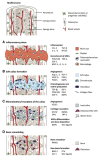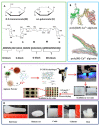Advances in Growth Factor Delivery for Bone Tissue Engineering
- PMID: 33477502
- PMCID: PMC7831065
- DOI: 10.3390/ijms22020903
Advances in Growth Factor Delivery for Bone Tissue Engineering
Abstract
Shortcomings related to the treatment of bone diseases and consequent tissue regeneration such as transplants have been addressed to some extent by tissue engineering and regenerative medicine. Tissue engineering has promoted structures that can simulate the extracellular matrix and are capable of guiding natural bone repair using signaling molecules to promote osteoinduction and angiogenesis essential in the formation of new bone tissues. Although recent studies on developing novel growth factor delivery systems for bone repair have attracted great attention, taking into account the complexity of the extracellular matrix, scaffolding and growth factors should not be explored independently. Consequently, systems that combine both concepts have great potential to promote the effectiveness of bone regeneration methods. In this review, recent developments in bone regeneration that simultaneously consider scaffolding and growth factors are covered in detail. The main emphasis in this overview is on delivery strategies that employ polymer-based scaffolds for spatiotemporal-controlled delivery of both single and multiple growth factors in bone-regeneration approaches. From clinical applications to creating alternative structural materials, bone tissue engineering has been advancing constantly, and it is relevant to regularly update related topics.
Keywords: biomaterials; bioscaffold; bone morphogenetic protein; bone regeneration; drug delivery; growth factor; polymer composites; tissue engineering.
Conflict of interest statement
The authors declare no conflict of interest.
Figures









Similar articles
-
Strategies for controlled delivery of growth factors and cells for bone regeneration.Adv Drug Deliv Rev. 2012 Sep;64(12):1292-309. doi: 10.1016/j.addr.2012.01.016. Epub 2012 Feb 4. Adv Drug Deliv Rev. 2012. PMID: 22342771 Free PMC article. Review.
-
Temporally controlled multiple-gene delivery in scaffolds: A promising strategy to enhance bone regeneration.Med Hypotheses. 2011 Feb;76(2):173-5. doi: 10.1016/j.mehy.2010.09.009. Med Hypotheses. 2011. PMID: 20926199
-
Growth Factor and Its Polymer Scaffold-Based Delivery System for Cartilage Tissue Engineering.Int J Nanomedicine. 2020 Aug 14;15:6097-6111. doi: 10.2147/IJN.S249829. eCollection 2020. Int J Nanomedicine. 2020. PMID: 32884266 Free PMC article. Review.
-
Recent Advances in Biomaterials for the Treatment of Bone Defects.Organogenesis. 2020 Oct 1;16(4):113-125. doi: 10.1080/15476278.2020.1808428. Epub 2020 Aug 16. Organogenesis. 2020. PMID: 32799735 Free PMC article. Review.
-
Growth Factor Delivery Using a Collagen Membrane for Bone Tissue Regeneration.Biomolecules. 2023 May 10;13(5):809. doi: 10.3390/biom13050809. Biomolecules. 2023. PMID: 37238679 Free PMC article. Review.
Cited by
-
Novel Strategies for Spatiotemporal and Controlled BMP-2 Delivery in Bone Tissue Engineering.Cell Transplant. 2024 Jan-Dec;33:9636897241276733. doi: 10.1177/09636897241276733. Cell Transplant. 2024. PMID: 39305020 Free PMC article. Review.
-
3D Bioprinting in Otolaryngology: A Review.Adv Healthc Mater. 2023 Jul;12(19):e2203268. doi: 10.1002/adhm.202203268. Epub 2023 Mar 31. Adv Healthc Mater. 2023. PMID: 36921327 Free PMC article. Review.
-
Hydrogels and Bioprinting in Bone Tissue Engineering: Creating Artificial Stem-Cell Niches for In Vitro Models.Adv Mater. 2023 Dec;35(52):e2301670. doi: 10.1002/adma.202301670. Epub 2023 Nov 2. Adv Mater. 2023. PMID: 37087739 Free PMC article. Review.
-
An Overview on the Big Players in Bone Tissue Engineering: Biomaterials, Scaffolds and Cells.Int J Mol Sci. 2024 Mar 29;25(7):3836. doi: 10.3390/ijms25073836. Int J Mol Sci. 2024. PMID: 38612646 Free PMC article. Review.
-
Recent advances in layer-by-layer assembly scaffolds for co-delivery of bioactive molecules for bone regeneration: an updated review.J Transl Med. 2024 Nov 5;22(1):1001. doi: 10.1186/s12967-024-05809-0. J Transl Med. 2024. PMID: 39501263 Free PMC article. Review.
References
-
- Ratnayake J.T., Ross E.D., Dias G.J., Shanafelt K.M., Taylor S.S., Gould M.L., Guan G., Cathro P.R. Preparation, characterisation and in-vitro biocompatibility study of a bone graft developed from waste bovine teeth for bone regeneration. Mater. Today Commun. 2020;22:100732. doi: 10.1016/j.mtcomm.2019.100732. - DOI
Publication types
MeSH terms
Substances
LinkOut - more resources
Full Text Sources
Other Literature Sources

